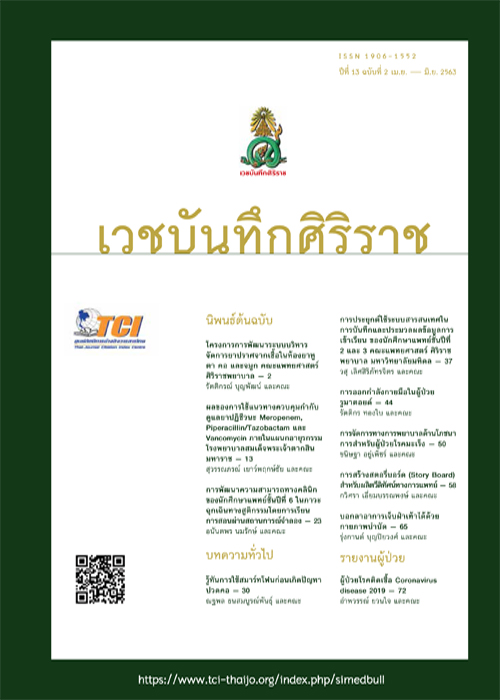โครงการการพัฒนาระบบบริหาร จัดการยาปราศจากเชื้อในห้องยา หู ตา คอ และจมูก คณะแพทยศาสตร์ ศิริราชพยาบาล
Main Article Content
Abstract
Objective: To develop the compounding sterile preparations management and to reduce waste from the
expired compounding sterile preparations at Ear Eye Nose Throat Pharmacy
Methods: The expiration date table for managing compounding sterile preparations was designed, implemented
and communicated to involved practitioners by QR code system. The numbers of expired compounding sterile
preparations were collected 4-month, before and after starting project at Ear Eye Nose Throat Pharmacy. The
effect of using this expiration date table was studied by comparing the numbers of expired compounding sterile
preparations 4-month before and after using the expiration date table. Descriptive and inferential statistics were
used in data analysis.
Results: Twenty-four of 3,020 items (0.80%) from ten types of compounding sterile preparations were found
expired during four months before starting the project. The waste costs 10,450 baht or 2,615 baht per month.
After using the expiration date table for 4 months, no expired medication was found (0.00%). Drug expiration
rate was statistically significant decreased (p<0.001).
Conclusion: The development of compounding sterile preparations management of Ear Eye Nose Throat Pharmacy
at Siriraj Hospital in this study can reduce the costs of expired medicines or prevent pharmaceutical waste.
Article Details
References
guidelines on compounding sterile preparations. Am J Health
Syst Pharm 2014;71:145-66.
2. Falconer JR, Steadman KJ. Extemporaneously compounded
medicines. Aust Prescr 2017;40:5-8.
3. Punyer J. Good practice guidance on expiry dates of medicines
[Internet]. 2018 [cited 2019 Jun 16]. Available from:
http://www.rotherhamccg.nhs.uk/Downloads/Top%20
Tips%20and%20Therapeutic%20Guidelines/Rotherham%20
CCG%20good%20practice%20guidance%20on%20expiry
%20dates%20of%20medicines.pdf
4. American Society of Health System Pharmacists. ASHP
guidelines on pharmacist-conducted patient education and
counseling. Am J Health Syst Pharm 1997;54:431-4.
5. Billstein-Leber M, Carrillo CJD, Cassano AT, Moline K,
Robertson JJ. ASHP guidelines on preventing medication
errors in hospitals. Am J Health Syst Pharm 2018;75:1493-517.
6. American Society of Hospital Pharmacists. ASHP technical
assistance bulletin on single unit and unit dose packages
of drugs. Am J Hosp Pharm 1985;42:378-9.
7. American Society of Hospital Pharmacists. ASHP technical
assistance bulletin on pharmacy-prepared ophthalmic
products. Am J Hosp Pharm 1993;50:1462-3.
8. Hammond RW, Walker TP, Fisher McClung H, Edmondson
W. Extemporaneous preparation of antibiotic ophthalmic
solutions. J Am Pharm Assoc 1996;36:206-9.
9. Nixon HK. Preparation of fortified antimicrobial eye drops.
Kerala J Ophthalmol 2018;30:152-4.
10. Kristina SA, Wiedyaningsih C, Widyakusuma NN, Aditama
H. Extemporaneous compounding practice by pharmacists:
A systematic review. Int J Pharm Pharm Sci 2017;9:42-6.
11. Al-Badriyeh D, Li J, Stewart K, Kong DCM, Leung L, Davies
GE, et al. Stability of extemporaneously prepared voriconazole
ophthalmic solution. Am J Health Syst Pharm 2009;66:
1478-83.
12. Neoh CF, Jacob J, Leung L, Li J, Stathopoulos A, Stewart
K, et al. Stability of extemporaneously prepared 0.5-percent
caspofungin eye drops: a potential cost-savings exercise.
Antimicrob Agents Chemother 2012;56:3435-7.
13. Khangtragool A, Khantawa B, Leesawat P. Potency of
extemporaneous gentamicin eye drops used in Maharaj
Nakorn Chiang Mai Hospital. CMU J Nat Sci 2009;8:161-4.
14. Newman C. How to reduce medicines waste. Pharm J
2011;3:26-31.
15. Bekker CL, Gardarsdottir H, Egberts ACG, Bouvy ML, Van den
Bemt BJF. Pharmacists’ activities to reduce medication waste:
An international survey. Pharmacy (Basel) 2018;6:94-107.
16. หน่วยข้อมูลยาและพิษวิทยา ฝ่ายเภสัชกรรม โรงพยาบาลศิริราช.
Solumedrol eye drop มีอายุ 1 เดือน. ศิริราชเภสัชสาร
[อินเทอร์เน็ต]. 2557 [เข้าถึงเมื่อ 2562 มิ.ย. 1]. เข้าถึงได้จาก: http://
www1.si.mahidol.ac.th/km/node/2561.
17. อภิรมย์ เหล่าเจริญเกียรติ. การปรับปรุงกระบวนการผลิตยาปฏิชีวนะ
สำหรับหยอดตา (Antibiotic Forte Eye Drop). ใน: ดวงมณี
เลาหประสิทธิพร, บรรณาธิการ. นวัตกรรมดีเด่น โครงการติดดาว
ประจำปี 2553 คณะแพทยศาสตร์ศิริราชพยาบาล มหาวิทยาลัย
มหิดล. กรุงเทพฯ: พี.เอ.ลีฟวิ่ง; 2555. หน้า 60-4.
18. นันท์นภัส ฟุ้งสุข, อัษฎางค์ พลนอก. การพัฒนาประสิทธิภาพการ
บริหารคลังเวชภัณฑ์ของโรงพยาบาลส่งเสริมสุขภาพตำบล อำเภออุทัย
จังหวัดพระนครศรีอยุธยา. วารสาร มฉก. วิชาการ 2560;21:109-22


